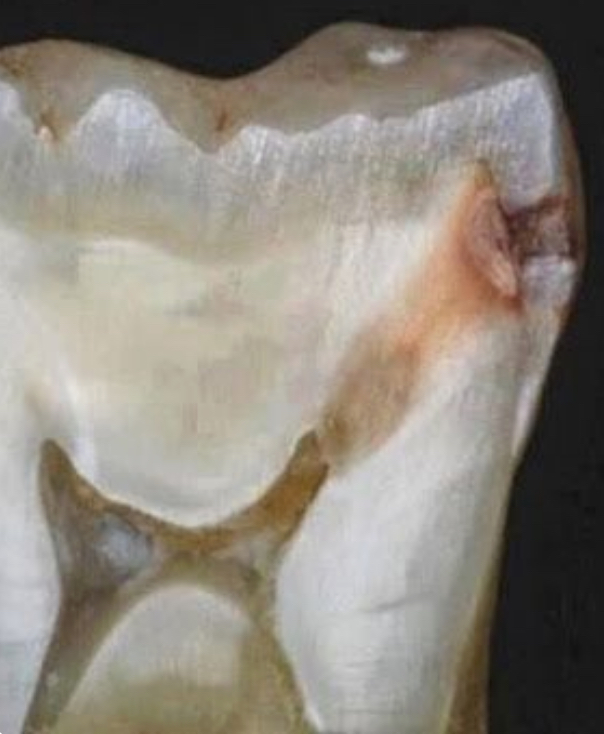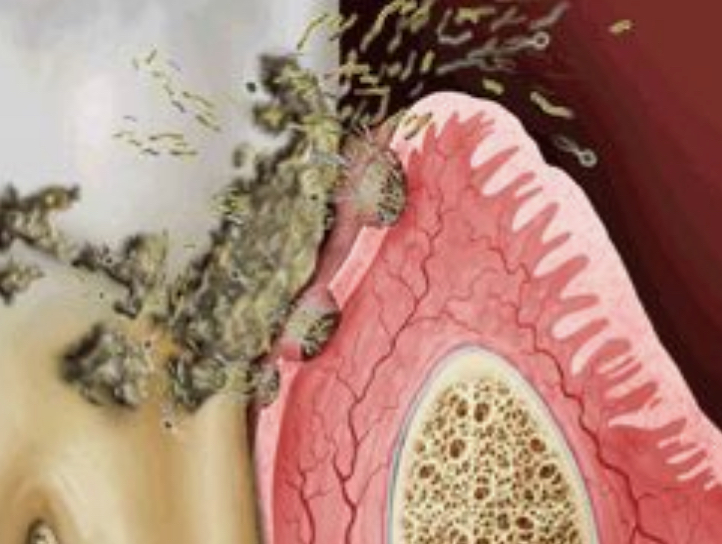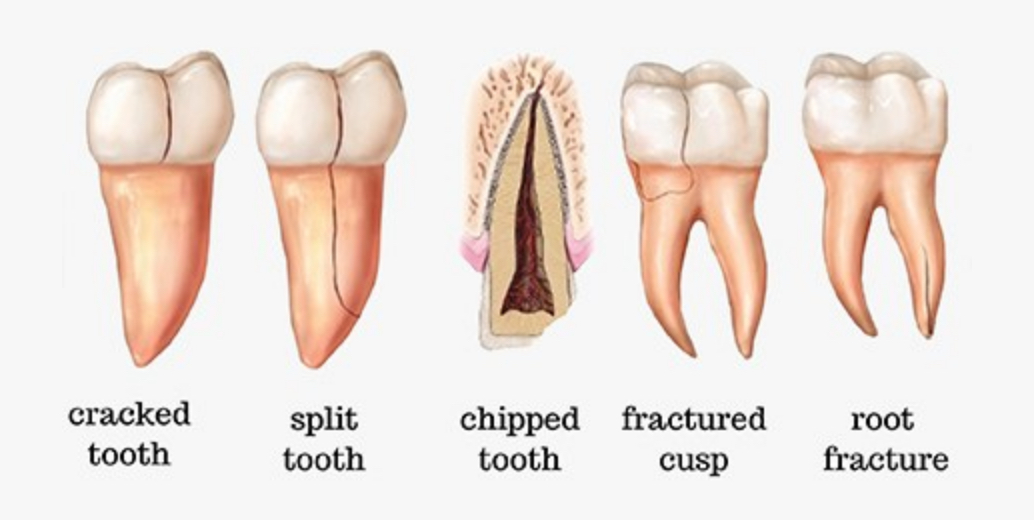Word of Mouth 2 . Sensitive Teeth

Sensitivity comes in all sorts of sizes and shapes and is a broad word often used to tell us “Something Hurts!
Broadly speaking there are different “types” of sensitivity: Temperature, Pressure and Spontaneous.
Usually pain and discomfort or sensitivity, is the body’s inflammatory response to something that is irritated.
If you think of an analogy when something irritates your finger or skin, the body’s response is to swell up and become red and inflamed. If you scratch or burn your finger, or have a splinter the skin swells up and goes red.
When you have a sensitive tooth there is something irritating the living tissue inside the tooth. This is called “PULP-ITIS” . Anything ending with “ITIS” means inflammation.
Pulpitis means inflammation of the pulp
This is usually the irritants/toxins from bacteria either in a cavity or leaking filling, or the bacteria on the outside of the exposed root surface, the plaque around the neck of the tooth.
These toxins irritate the living tissue in the core of the tooth but they cannot swell up inside the rigid cavity of the tooth. Instead the nerves become more responsive to normal stimuli.
The real question to ask is:
“What is making my teeth sensitive?” or “What is the cause of the irritation.”
So when you have sensitive teeth - Ask your dentist!
They will look for the cause and your answer will give them the clues they need.
It is helpful to make a note to describe the pain or sensitivity.
1 What makes it hurt? Hot / cold / pressure / eating / tapping
2. How long does the pain linger? 10 seconds, 2 min 10 min or more )
3. Does the pain come on by itself? Yes / No eg. mealtimes, cold drink
4. How intense is the pain? Record a score out of 10 ( 10 being highest )
5 How long have you had it? Days, weeks, longer.
They may look for a cavity or decay.
They may check for any failing or faulty fillings.
They will look for gum disease.
Does anything make it better.
They may take x rays to see between your teeth, under the fillings or the bone around you roots
Causes of Sensitivity:
1. Decay / failing filling.
2. Dental Abbcess / infection.
3. Gum disease / recession.
4. Grinding ( or occlusion )
5. Fractured teeth.
6. Excessive or inappropriate Dental Bleaching.
Decay. If you have a cavity or a leaking filling, bacteria can progress closer to the living middle of the tooth. As it does so structure or scaffolding of the inside of the tooth collapses, it may become darker in colour and eventually the living tissue of the tooth tries to swell as it becomes inflamed. If you remove the decay and seal the leak early enough, this removes the irritant and the toothache fades as the nerve tissue heals. Think of this a a slate loose on the roof. If you wait, the rain will get into the kitchen. If you act early, you simply have to replace the slate. Early intervention is always easier, less expensive.
Dental Abcess / Infection / Root Canal If the decay gets too close or is removed too late, or is not discovered at all, the living core of the tooth dies and the rotten tissue leaks into the bone at the tip of the root. This infection is called an abscess.
If the core of the tooth is dead or dying, there are normally two choices, both effectively “clean the wound” and remove the source of infection
1. Extract the tooth.
2. Remove the infected tissue inside the tooth with a bit of “plumbing” Root canal therapy is just that. if needed we can clean the core of the tooth with tiny pipe cleaners, sterilise the canals that are left and seal these up, right unto the tip of the root. We will discuss this further another day.
Gums : How good is your plaque control around the neck of the teeth, especially in the collar or cuff of gum around the neck of the tooth? (We call this the Periodontal pocket.)
If your gums have receded or shrunk because of gum disease, the exposed tooth surface is not covered by the enamel. The root surface is made of dentine, a fascinating structure made of millions of tiny “tubes” which will carry the toxins or the cold into the dentine and never to the living tissue in the core of the tooth. Fractured teeth.
Teeth are actually incredibly strong. They are beautifully designed eating utensils but they take an awful lot of punishment, daily wear and tear and nowadays we hope to keep our teeth for life.
However if they have been weakened over the years by the cycle of decay and filling, wear from load and further decay, eventually the mechanics of the remains tooth may fail and a corner of the tooth may fracture and break off.
This exposes the sensitive part of the tooth and will need to be assessed by you dentist. If there is enough tooth left they may be able to protect the sensitivity and build the tooth back up with a larger filling or with a crown
Grinding : Sensitivity can also be related to the way you bite. If you are missing teeth and the remaining teeth are bearing more load than they are designed to, this will throw more weight onto the tooth and sort of “bruise” the living tissue in and around the tooth.
Do you grind your teeth? This is called Bruxism ( useful scrabble word ) or sometimes night grinding. This can overload the teeth and it’s a bit like doing a marathon every night for some people’s teeth. This extra wear and load can precipitate a cascade of problems. People often grind their teeth more in times of stress or tension. Classically more common with students doing exams, long or changing workhours, family stresses such as bereavement , illness or weddings.
In some patients the sensitivity may also be from a “Crack” in the tooth.
Fractured teeth : There are many different ways a tooth can crack, so the kind of treatment a tooth needs will depend on the type, location, and extent of the damage. Some common types of cracks are:
Craze Lines: These cracks are very small and usually cause no trouble for a tooth other than perhaps affecting its appearance. If severe enough, they can be addressed with cosmetic dentistry.
Fractured Cusp: A cusp is another name for a tooth’s chewing surface, and pieces of it often break off when a tooth has been treated with a filling. This very rarely damages the dental pulp and usually doesn’t cause much pain. Typically, a dentist can fix this by applying a new restoration.
Cracked Tooth: Technically, a cracked tooth means that a crack in the enamel extends from the chewing surface vertically towards the root. If the crack extends to the pulp, it can often be treated with root canal therapy. However, if the crack goes all the way past the gum line, it will no longer be treatable and will have to be extracted. That’s why you should seek out treatment as soon as you suspect you have a cracked tooth.
Split Tooth: A split tooth means that a crack has extended all the way through a tooth but has not progressed past the gum line yet. The entire tooth cannot be saved, but portions of it may be. In most cases, root canal therapy can be performed to save most of the tooth.
Vertical Root Fracture: This is a crack that starts at the root and extends towards the chewing surface of a tooth. They often cause minimal symptoms which can make them easy to not notice. They are often discovered when the surrounding bone and gum tissue have become infected. The tooth may need to be extracted, or endodontic surgery could be used to save most of the tooth by removing just the fractured portion.
Excessive or Inappropriate Dental Bleaching.
Whitening teeth professionally can be very effective. Please do seek professional advice first from your dentist. Some patients should not whiten or bleach their teeth and the dentist can check to ensure you first have no gum problems, no recession, no fillings in your front teeth that are of concern.
They will also advice you what sort of whitening technique will be best for you.
Bear in mind the home whitening “strips” are less than 0.1 % active ingredient. The professional techniques are unto 6% active gel .
The latter are many many times more effective than the home strips.
Tips and tricks
If you have sensitivity, what should you do?
1. Don’t wait until a minor sensitivity becomes worse! It is always easier to fix a smaller problem before it is a bigger problem and it will both cost less and likely be more successful.
2. Make a note of the symptoms as above.
3. Ask your dentist to identify the cause of the irritation, be it any of the above, a failing filling, an accumulation of plaque or gum disease, excessive load or a cracked tooth ….. and ask their advice and ask what choices you have.
Stay safe.
Dr Paul Moore BDS

20 Comment(s)
best cutting steroids
cops and robbers games
https://git.louislabs.com/gerardorider6\r\n\r\n\r\nhttps://www.superphage.org/adriene9439075\r\n\r\n\r\nhttps://gogs.pinadshub.com/nolanchewning9\r\n\r\n\r\nhttps://hipstrumentals.net/lurlenen138798\r\n\r\n\r\nhttps://projects.om-office.de/albertha194691/7718174/-/issues/5\r\n\r\n\r\nhttps://worship.com.ng/lawerencesands\r\n\r\n\r\nhttps://git.hanckh.top/bettecoventry\r\n\r\n\r\nhttps://git.mista.ru/adolfobaeza612\r\n\r\n\r\nhttps://ljs.fun:19000/katricelatimer\r\n\r\n\r\nhttps://git.louislabs.com/susannepjk398\r\n\r\n\r\nhttps://lab.nltvc.com/maedew46794686\r\n\r\n\r\nhttps://repo.komhumana.org/craigy2331276\r\n\r\n\r\nhttps://git.ides.club/adolphprout189\r\n\r\n\r\nhttps://sound.descreated.com/madisonpurnell\r\n\r\n\r\nhttps://quickdate.arenascript.de/@gabriellaujn8\r\n\r\n\r\nhttps://repo.komhumana.org/adrianacohen83\r\n\r\n\r\nhttps://git.droenska.com/steffenlankfor\r\n\r\n\r\nhttps://pleroma.cnuc.nu/chandraicely1\r\n\r\n\r\nhttps://git.ellinger.eu/aleidastradbro/blackcoin.co1988/wiki/Premium-Online-Gaming-Experience-in-Australia\r\n\r\n\r\nhttps://niubillity.com:3000/dalenecarswell/dalene2023/wiki/Official+Site+For+Aussies+2025\r\n\r\n\r\nhttps://isabelzarate.com/graiggardin977
https://gitea.micro-stack.org/verlahebblethw\r\n\r\n\r\nhttps://git.ism-dev.net/walterbautista\r\n\r\n\r\nhttps://git.kirasparkle.de/shelleymcvicar/shelley2018/wiki/Review-of-Ricky-Online-Casino-in-Australia\r\n\r\n\r\nhttps://nrisoulmate.com/@franciscobolli\r\n\r\n\r\nhttps://gitea.blubeacon.com/cornelius01q94\r\n\r\n\r\nhttps://git.bremauer.cc/jamal891613879\r\n\r\n\r\nhttps://smusic.sochey.com/joannakulakows\r\n\r\n\r\nhttps://smusic.sochey.com/ginawink05271\r\n\r\n\r\nhttps://gitea.fuluzhanggui.com:99/alejandraworth/blackcoin.co1987/wiki/King-Billy-Casino-Games%3A-Slots%2C-Live-Dealer%2C-Jackpots\r\n\r\n\r\nhttps://git2.huai-yun.com/jaynefoxall450/2646blackcoin/wiki/Leon-Casino-AU-Real-Money-Pokies-and-Live-Games-Online\r\n\r\n\r\nhttps://selfloveaffirmations.net/@genevievesambe\r\n\r\n\r\nhttps://git.ism-dev.net/isabellalipsey\r\n\r\n\r\nhttps://learninghub.fulljam.com/@lucieheflin684?page=about\r\n\r\n\r\nhttps://git2.huai-yun.com/fmptyrell2878/blackcoin.co7341/wiki/Play-Slots%2C-Table-Games-%26-Live-Casino-Online\r\n\r\n\r\nhttps://gitea.noname-studios.es/abbyoctoman513\r\n\r\n\r\nhttps://onetouch-git.thxpace.com/otispride14591/blackcoin5369/-/issues/1\r\n\r\n\r\nhttps://srsbkn.eu.org/cooperflanders\r\n\r\n\r\nhttps://gitea.nongnghiepso.com/andersonlightf\r\n\r\n\r\nhttps://gitea.theaken.com/caridaddelapen\r\n\r\n\r\nhttps://qrew.social/read-blog/10723_aussie-casino-games-play-pokies-with-quickie-boost-bonuses-top-slots-2025-fairgo.html\r\n\r\n\r\nhttps://www.toparma.com/bertha64m06840
https://gitea.svc.obaa.cloud/ellielarocque0\r\n\r\n\r\nhttps://slowdating.ca/@denisbaez42375\r\n\r\n\r\nhttps://git.ezmuze.co.uk/robinewald2987/2869802/wiki/Star-Casino-walks-from-Queens-Wharf-sale-in-Brisbane-after-%24300m-Ballys-lifeline\r\n\r\n\r\nhttps://git.wisder.net/eugeniamcilvee/2659603/wiki/Fair-Go-Casino-Login-Sign-In-to-Your-Player-Account\r\n\r\n\r\nhttps://git.rokiy.com/alfredlabbe598\r\n\r\n\r\nhttps://git.hexdive.com/judekavel78933\r\n\r\n\r\nhttps://git.ism-dev.net/andretunstall\r\n\r\n\r\nhttps://worldclassdjs.com/freemany543775\r\n\r\n\r\nhttps://vcs.int.feuerwehr-ziemetshausen.de/earlenespruson\r\n\r\n\r\nhttps://git.getmind.cn/amadopickard77\r\n\r\n\r\nhttps://gitea.synapsetec.cn/adalbertokirto\r\n\r\n\r\nhttps://joylife.in/read-blog/18921_login-welcome-bonus-up-to-1000.html\r\n\r\n\r\nhttps://gitea.blubeacon.com/rachaelpaschal\r\n\r\n\r\nhttps://www.aservicehost.ru/miragranville8\r\n\r\n\r\nhttps://purednacupid.com/@isiahbreeze15\r\n\r\n\r\nhttps://giteap.grobest.com:3000/anjalemessurie\r\n\r\n\r\nhttps://thekissmet.com/@danielehudgins\r\n\r\n\r\nhttps://gofleeks.com/read-blog/3225_treasury-casino-australia-gaming-dining-and-luxury-in-brisbane.html\r\n\r\n\r\nhttps://gitea.kdlsvps.top/alejandrinahar\r\n\r\n\r\nhttps://git.mklpiening.de/alfieyar962870/alfie2008/wiki/Online-Casinos-for-USA-Players-Play-at-Trusted-US-Casino-Sites\r\n\r\n\r\nhttps://gitea.tpss.top/lukehauslaib4
https://www.cloud.file.futurestack.cn/athenag5827360\r\n\r\n\r\nhttps://sistemagent.com:8081/arleen99525813/6684blackcoin.co/wiki/The+Best+Online+Casino+Choices+in+Australia\r\n\r\n\r\nhttps://isabelzarate.com/michelleenyear\r\n\r\n\r\nhttps://www.fastmarry.com/@adelehain53977\r\n\r\n\r\nhttps://git.lodis.se/fejtera161098\r\n\r\n\r\nhttps://git.yangzhiqiang.tech/chasetunbridge\r\n\r\n\r\nhttps://git.bremauer.cc/trudihofmann26/blackcoin.co5400/wiki/Best-Online-Casino-for-Aussies\r\n\r\n\r\nhttps://lambrg.com/read-blog/17839_real-money-gaming-on-ios-amp-android-usa.html\r\n\r\n\r\nhttps://camtalking.com/@spencergatty13\r\n\r\n\r\nhttps://gog.taletrail.fi/bernicegaunson/2024306/wiki/Pokies+That+Load+Fast%252C+Pay+Faster\r\n\r\n\r\nhttp://110.41.138.175:3000/roslyn78482010\r\n\r\n\r\nhttps://git.mklpiening.de/tristastace500/blackcoin8299/wiki/The-Star-Gold-Coast-Asia-Casino-Premium-Club-ACPC-Gaming\r\n\r\n\r\nhttps://www.ouarte.garden/deanleist95020\r\n\r\n\r\nhttps://www.nxgit.xyz/alannahbejah76\r\n\r\n\r\nhttps://rjlove.org/@albertabar9975\r\n\r\n\r\nhttps://thekissmet.com/@majorcrx353278\r\n\r\n\r\nhttps://nrisoulmate.com/@zellamacklin65\r\n\r\n\r\nhttps://naijasingles.net/@wandag3419896\r\n\r\n\r\nhttps://www.rilezzz.com/read-blog/22296_gaming-promotions-and-exciting-mobile-experience.html\r\n\r\n\r\nhttps://git.thweb.net/warner1662259\r\n\r\n\r\nhttps://gitea.blubeacon.com/eugenewooten50/blackcoin1980/wiki/The-Star%2C-Sydney-Wikipedia
https://git.ezmuze.co.uk/joesphluncefor/3530268/wiki/Fair-Go-Casino-AU-Review-Bonuses%2C-Promotions%2C-Games\r\n\r\n\r\nhttps://zurimeet.com/@jennietorgerso\r\n\r\n\r\nhttps://newborhooddates.com/@myrtlealtman48\r\n\r\n\r\nhttps://gitea.mpc-web.jp/antoinettefrid\r\n\r\n\r\nhttps://gogs.koljastrohm-games.com/darbywrigley00\r\n\r\n\r\nhttps://icas.life/read-blog/3335_login-to-winspirit-in-australia.html\r\n\r\n\r\nhttps://repo.apps.odatahub.net/salvatoreholzm\r\n\r\n\r\nhttps://git.simbarbet.com/aidanpagan493\r\n\r\n\r\nhttps://repo.komhumana.org/mosesgoldschmi\r\n\r\n\r\nhttps://www.chembans.com/@margretwasson\r\n\r\n\r\nhttps://isabelzarate.com/michelleenyear\r\n\r\n\r\nhttps://git.mikspec.pl/cedrictwopeny\r\n\r\n\r\nhttps://isabelzarate.com/sammypohlman3\r\n\r\n\r\nhttps://git.daneric.dev/anhhodson82725\r\n\r\n\r\nhttps://git.mikspec.pl/alejandrabardo/1529blackcoin/wiki/The+Star+Gold+Coast+Luxury+hotel+on+the+Gold+Coast\r\n\r\n\r\nhttps://git.rokiy.com/sherriecorriga\r\n\r\n\r\nhttps://gitea.pnkx.top:8/jessie60s7820\r\n\r\n\r\nhttps://voyostars.com/read-blog/25887_about-us-minnesota-casino-hotel-and-event-center-in-mahnomen-minnesota.html\r\n\r\n\r\nhttps://gogs.optch.top/deangelothreat\r\n\r\n\r\nhttps://git.sudo-fhir.au/betseyserna812\r\n\r\n\r\nhttps://nrisoulmate.com/@alizaboynton02
https://git.kirasparkle.de/andersonhomer8/blackcoin.co7900/wiki/Real-Money-Pokies-and-Fast-Withdrawals\r\n\r\n\r\nhttps://git.rbsx.de/kandyjarnagin7\r\n\r\n\r\nhttps://meeting2up.it/@rachell2153209\r\n\r\n\r\nhttps://www.soundofrecovery.org/elmolantz65032\r\n\r\n\r\nhttps://www.jr-it-services.de:3000/indirabrookshi\r\n\r\n\r\nhttps://grafana.jasonstolle.com/kristyseppelt/blackcoin2011/wiki/Skycrown-Casino-AU-Review-Bonuses%2C-Promotions%2C-Games\r\n\r\n\r\nhttps://www.nemusic.rocks/kenneth02u081\r\n\r\n\r\nhttps://www.meetgr.com/@allangladden15\r\n\r\n\r\nhttp://softwarescience.top:3000/markmarte75842/mark1985/wiki/Top+10+Online+Casinos+for+Real+Money+in+Australia+November+2025\r\n\r\n\r\nhttps://repos.ubtob.net/margaritaoconn\r\n\r\n\r\nhttps://matchmingle.fun/@rigobertoespie\r\n\r\n\r\nhttps://git.vhdltool.com/aguedaamaya50\r\n\r\n\r\nhttps://gitea.sguba.de/astridkruttsch\r\n\r\n\r\nhttps://git.svidoso.com/syreetaspy3985\r\n\r\n\r\nhttps://git.hanckh.top/gertienorton0\r\n\r\n\r\nhttps://git.ultra.pub/christopherand\r\n\r\n\r\nhttps://git.kirasparkle.de/andersonhomer8/blackcoin.co7900/wiki/Real-Money-Pokies-and-Fast-Withdrawals\r\n\r\n\r\nhttps://moonifie.com/read-blog/87095_special-poker-features.html\r\n\r\n\r\nhttps://git.hanckh.top/gertienorton0\r\n\r\n\r\nhttps://leafreward.com/read-blog/7084_play-slots-table-games-amp-live-casino-online.html\r\n\r\n\r\nhttps://syq.im:2025/annettecadwall
https://cribbn.com/read-blog/12236_crown-perth-gains-suitable-finding-to-retain-casino-license.html\r\n\r\n\r\nhttps://sithcom.de/ahmada2368278\r\n\r\n\r\nhttps://platform.giftedsoulsent.com/anyahooten961\r\n\r\n\r\nhttps://aipod.app/rosalindamcalp\r\n\r\n\r\nhttps://www.superphage.org/vedaz512816819\r\n\r\n\r\nhttps://git.ghostpacket.org/princesslabord\r\n\r\n\r\nhttps://net.smartedge.com.ng/read-blog/9874_richard-casino-opptil-50-000-kr-bonus-registrer-logg-inn.html\r\n\r\n\r\nhttp://gogs.lashuju.com/aimeelauer8759/3984384/wiki/Online+Pokies%252C+Mobile+Play+%2526+Fast+AU%2524+Withdrawals\r\n\r\n\r\nhttps://clients.git.marv.pw/budsaywell9029/6566blackcoin.co/wiki/Sign+In+to+Your+Account+Safely\r\n\r\n\r\nhttps://scrape.weidautzel.de/ednabauer2828\r\n\r\n\r\nhttps://txuki.duckdns.org/adrianoferrall/4918648/wiki/Top-Online-Casinos-in-Australia-2025-AUS-Real-Money-Sites\r\n\r\n\r\nhttps://www.arabianmatrimony.com/@adamgist456848\r\n\r\n\r\nhttps://git.fhlz.top/colettelefler/claude2009/wiki/Boost-Your-Bankroll%3A-Claim-Fair-Go-Casino-VIP-Bonus-Codes\r\n\r\n\r\nhttps://gitea.gimmin.com/adelinekable9\r\n\r\n\r\nhttps://git.morozoff.pro/dwayneoaks634\r\n\r\n\r\nhttps://dev.dhf.icu/nikolewiles372\r\n\r\n\r\nhttps://gitea.quiztimes.nl/kuslesli268758\r\n\r\n\r\nhttps://scrape.weidautzel.de/ednabauer2828\r\n\r\n\r\nhttps://friendza.enroles.com/read-blog/92493_australia-039-s-trusted-online-casino.html\r\n\r\n\r\nhttps://kiochat.com/read-blog/201_king-billy-casino-review-is-legit-safe-in-2025.html\r\n\r\n\r\nhttps://phoebe.roshka.com/gitlab/eulaliawhitesi
https://savg.in/dyanlnp5395651\r\n\r\n\r\nhttps://stayzada.com/bbs/board.php?bo_table=free&wr_id=467050\r\n\r\n\r\nhttp://seoul911.com/bbs/board.php?bo_table=free&wr_id=26\r\n\r\n\r\nhttps://jobstaffs.com/employer/the-ville-resort-casino-and-ardo/\r\n\r\n\r\nhttp://www.sunti-apairach.com/nakhonchum1/index.php?name=webboard&file=read&id=1040102\r\n\r\n\r\nhttps://centerdb.makorang.com:443/bbs/board.php?bo_table=qa&wr_id=80693\r\n\r\n\r\nhttps://www.toutsurlemali.ml/employer/list-of-casinos-in-sydney/\r\n\r\n\r\nhttps://jobs.sharedservicesforum.in/employers/rooms/\r\n\r\n\r\nhttps://i-medconsults.com/companies/king-billy-casino-au-royal-pokies-crypto-withdrawals/\r\n\r\n\r\nhttps://7or.net/guillermowan6\r\n\r\n\r\nhttps://1page.bio/willieruth\r\n\r\n\r\nhttps://qr.nub-1.com/lorribeor87287\r\n\r\n\r\nhttp://cheongchunplant-as.com/bbs/board.php?bo_table=free&wr_id=304979\r\n\r\n\r\nhttp://www.129koreaems.com/bbs/board.php?bo_table=free&wr_id=6\r\n\r\n\r\nhttps://seoulthegowoon.com/bbs/board.php?bo_table=free&wr_id=488877\r\n\r\n\r\nhttps://www.dynamicviewpoint.co.uk/employer/atg-asx-star-chair-anne-wards-faces-shareholder-revolt-at-redbubble-owner-articore/\r\n\r\n\r\nhttps://citymanagementjobs.com/employer/best-online-casinos-in-australia-top-real-money-casinos-in-2025/\r\n\r\n\r\nhttps://koftc.com/bbs/board.php?bo_table=free&wr_id=28\r\n\r\n\r\nhttps://werkstraat.com/companies/luxury-gaming-hotels-fine-dining-in-barangaroo/\r\n\r\n\r\nhttps://working.altervista.org/employer/the-star-sydney/\r\n\r\n\r\nhttps://jobsintransport.com.au/companies/the-star-entertainment-group-limited-stock-sgr/
https://hirenhigher.co.nz/companies/7bit-casino-no-deposit-bonus-75-free-spins-promo-code/\r\n\r\n\r\nhttps://artisfinishing.com/amparoquarles\r\n\r\n\r\nhttp://gyeongshin.co.kr/kscn/bbs/board.php?bo_table=free&wr_id=912625\r\n\r\n\r\nhttps://jobsrific.com/employer/crown-sydney-casino-crown-sydney-casino-review-2025/\r\n\r\n\r\nhttps://www.cdlcruzdasalmas.com.br/portal_de_empregos/companies/best-online-casinos-2025/\r\n\r\n\r\nhttps://judicioushr.com/employer/login-no-deposit-bonus/\r\n\r\n\r\nhttp://dodo00.dothome.co.kr/bbs/board.php?bo_table=1_2&wr_id=350286\r\n\r\n\r\nhttps://cuttify.io/debbragrullon0\r\n\r\n\r\nhttp://m.xn--vf4b15l12a6a.net/sejongzio/bbs/board.php?bo_table=_notice&wr_id=253\r\n\r\n\r\nhttps://viplink.us/AYorJ\r\n\r\n\r\nhttps://manpoweradvisors.com/employer/quick-registration-guide/\r\n\r\n\r\nhttps://globejobsaid.com/employer/casino-app-21-bit-download-the-apk-and-win-real-money/\r\n\r\n\r\nhttps://queryforjob.com/employer/cashman-casino-slots-games-by-product-madness/\r\n\r\n\r\nhttps://laboryes.com/employer/10-best-real-money-online-casinos-in-australia-for-2025-february-update/\r\n\r\n\r\nhttps://epsart.kr/bbs/board.php?bo_table=free&wr_id=1208\r\n\r\n\r\nhttps://cuttify.io/debbragrullon0\r\n\r\n\r\nhttps://www.livorise.com/employer/15-best-online-casinos-australia-2025-real-money-casino-sites/\r\n\r\n\r\nhttps://behired.eu/employer/cashman-casino-unveils-faster-login-process-for-instant-slot-access/\r\n\r\n\r\nhttp://www.affair.co.kr/bbs/board.php?bo_table=free&wr_id=556936\r\n\r\n\r\nhttps://40tag.com/gingerprio\r\n\r\n\r\nhttps://talentbridj.com/employer/you-can-get-an-australian-no-deposit-bonus-at-joe-fortune-casino/
rolling hills casino\r\n\r\n\r\nhttp://chansolburn.com/bbs/board.php?bo_table=free&wr_id=1258667 chansolburn.com\r\n\r\n\r\nhttp://app.vellorepropertybazaar.in/profile/blainecayton9 app.vellorepropertybazaar.in\r\n\r\n\r\nhttp://www.century-korea.com/bbs/board.php?bo_table=free&wr_id=13 http://www.century-korea.com/bbs/board.php?bo_table=free&wr_id=13\r\n\r\n\r\nhttps://clarktour.co.kr/g5/bbs/board.php?bo_table=free&wr_id=38 https://clarktour.co.kr\r\n\r\n\r\nhttps://timviec24h.com.vn/companies/10-best-online-casinos-in-australia-for-real-money-in-2025/ timviec24h.com.vn\r\n\r\n\r\nhttp://www.affair.co.kr/bbs/board.php?bo_table=free&wr_id=557002 http://www.affair.co.kr\r\n\r\n\r\nhttps://clkme.pro/holliedayton01 clkme.pro\r\n\r\n\r\nhttps://zenfilm.solutions/mittiedelatorr zenfilm.solutions\r\n\r\n\r\nhttps://jobsharmony.com/companies/joe-fortune-casino-no-deposit-bonus-promo-codes-2025/ jobsharmony.com\r\n\r\n\r\nhttps://dinhdanh.com/charaodris dinhdanh.com\r\n\r\n\r\nhttp://woorisusan.kr/bbs/board.php?bo_table=free&wr_id=197365 http://woorisusan.kr/bbs/board.php?bo_table=free&wr_id=197365\r\n\r\n\r\nhttp://ww.yeosunet.com/bbs/board.php?bo_table=free&wr_id=159580 http://ww.yeosunet.com/\r\n\r\n\r\nhttps://thaijobhub.com/employer/star-entertainment-signs-300m-lifeline-deal-with-us-gaming-giant-ballys/ thaijobhub.com\r\n\r\n\r\nhttps://dfc1318.kr/bbs/bbs/board.php?bo_table=free&wr_id=1443 https://dfc1318.kr/\r\n\r\n\r\nhttps://eujobss.com/employer/discover-exciting-casino-games-at-cashman-casino/ https://eujobss.com/employer/discover-exciting-casino-games-at-cashman-casino\r\n\r\n\r\nhttps://fastlinks.com.tr/willymchugh235 fastlinks.com.tr\r\n\r\n\r\nhttps://gizemarket.com/companies/best-online-casinos-in-australia-2025-safe-trusted-sites/ https://gizemarket.com/\r\n\r\n\r\nhttps://www.pakgovtnaukri.pk/companies/king-billy-casino-detailed-review-2025/ www.pakgovtnaukri.pk
play online casino games\r\n\r\n\r\nhttps://jam2.me/faustobert https://jam2.me/faustobert\r\n\r\n\r\nhttp://ww.yeosunet.com/bbs/board.php?bo_table=free&wr_id=159572 ww.yeosunet.com\r\n\r\n\r\nhttps://iplawjobs.com/employer/who-owns-cairns-casino/ https://iplawjobs.com\r\n\r\n\r\nhttps://storiediviaggio.com/lavernlinkous5 storiediviaggio.com\r\n\r\n\r\nhttps://sigorta.jobs/employer/about/ https://sigorta.jobs/\r\n\r\n\r\nhttps://remoteaijobs.ai/employer/the-star-entertainment-group-limited-stock-sgr/ https://remoteaijobs.ai\r\n\r\n\r\nhttps://firstcanadajobs.ca/employer/my-fortune-oy-linkedin/ https://firstcanadajobs.ca\r\n\r\n\r\nhttp://medik.co.kr/bbs/board.php?bo_table=free&wr_id=1760482 medik.co.kr\r\n\r\n\r\nhttps://link.1hut.ru/mariegoodenoug https://link.1hut.ru/mariegoodenoug\r\n\r\n\r\nhttps://link.1hut.ru/leifcarnarvon6 link.1hut.ru\r\n\r\n\r\nhttp://medifore.co.jp/bbs/board.php?bo_table=free&wr_id=4806226 medifore.co.jp\r\n\r\n\r\nhttp://www.affair.co.kr/bbs/board.php?bo_table=free&wr_id=556740 www.affair.co.kr\r\n\r\n\r\nhttps://istincy.com/kristanbodenwi https://istincy.com/kristanbodenwi\r\n\r\n\r\nhttps://ah.my/rosariomansom9 https://ah.my/rosariomansom9\r\n\r\n\r\nhttp://app.vellorepropertybazaar.in/profile/franciscodamro app.vellorepropertybazaar.in\r\n\r\n\r\nhttps://icskorea.co.kr/bbs/board.php?bo_table=free&wr_id=516652 icskorea.co.kr\r\n\r\n\r\nhttps://itheadhunter.vn/jobs/companies/ozwin-casino-login-and-registration-with-bonus/ itheadhunter.vn\r\n\r\n\r\nhttps://jam2.me/chaneledwi https://jam2.me/chaneledwi
https://ttl01.com/bbs/board.php?bo_table=free&wr_id=355132\r\n\r\n\r\nhttps://linksshortcut.com/laynequinlan09\r\n\r\n\r\nhttp://woorisusan.kr/bbs/board.php?bo_table=free&wr_id=197365\r\n\r\n\r\nhttps://patriciusit.com/employer/crown-casino-sydney-a-comprehensive-review-of-casino-features/\r\n\r\n\r\nhttps://wsurl.link/6njmr1\r\n\r\n\r\nhttps://agenceglobalpro.com/employer/7494/best-casino-hotels-in-townsville-from-86\r\n\r\n\r\nhttps://aba.work/employer/22250/joe-fortune-casino-review-2025-5000-welcome-bonus-450-fs\r\n\r\n\r\nhttp://thdeco.com/bbs/board.php?bo_table=free&wr_id=331711\r\n\r\n\r\nhttps://www.jssystems.co.kr/bbs/board.php?bo_table=free&wr_id=36674\r\n\r\n\r\nhttps://s.sanphamso.vn/margueritegwin\r\n\r\n\r\nhttps://gizemarket.com/companies/ozwin-casino-login-unlock-epic-bonuses-and-slots-today/\r\n\r\n\r\nhttps://seoulthegowoon.com/bbs/board.php?bo_table=free&wr_id=488905\r\n\r\n\r\nhttp://aanline.com/eng/board/bbs/board.php?bo_table=free&wr_id=173024\r\n\r\n\r\nhttps://fs-biolink.com/beatriztucker\r\n\r\n\r\nhttps://ibio.app/wayneedw23\r\n\r\n\r\nhttps://jobs-classifieds.com/employer/7bitcasino-crypto-gambling-site/\r\n\r\n\r\nhttps://stepfortune.com/employer/21bit-casino-the-best-crypto-casino-for-australian-players/\r\n\r\n\r\nhttps://infinitystaffingsolutions.com/employer/detailed-guide-to-top-features-in-online-casinos-in-australia/\r\n\r\n\r\nhttps://r12imob.store/index.php?page=user&action=pub_profile&id=907749\r\n\r\n\r\nhttps://winacess.com/employer/13971/lucky-ones-casino-lucky-ones-casino-australia-lucky-ones-login\r\n\r\n\r\nhttps://mtwd.link/chasbogen76990
microgaming online casino\r\n\r\n\r\nhttps://koftc.com/bbs/board.php?bo_table=free&wr_id=27 https://koftc.com/bbs/board.php?bo_table=free&wr_id=27\r\n\r\n\r\nhttps://cut.gl/merlincarnes58 cut.gl\r\n\r\n\r\nhttps://savg.in/adela84p293740 savg.in\r\n\r\n\r\nhttps://dancemua.com/bbs/board.php?bo_table=free&wr_id=438479 dancemua.com\r\n\r\n\r\nhttps://xqr.ai/soniatoups https://xqr.ai\r\n\r\n\r\nhttps://aurelus.link/yolanda4279868 aurelus.link\r\n\r\n\r\nhttps://fanajobs.com/profile/jaclyndooley6 fanajobs.com\r\n\r\n\r\nhttps://cannabisjobs.solutions/companies/casino-new-south-wales-wikipedia/ https://cannabisjobs.solutions/\r\n\r\n\r\nhttps://www.sitiosperuanos.com/author/ycpdonnell/ www.sitiosperuanos.com\r\n\r\n\r\nhttps://remotelytech.com/employer/396686/why-chris-morris-bought-worst-performing-casino-in-australia/ remotelytech.com\r\n\r\n\r\nhttps://ghibta.org/employer/entertainment-calendar/ https://ghibta.org/\r\n\r\n\r\nhttps://careeredupersonnel.com/employer/joe-fortune-casino/ careeredupersonnel.com\r\n\r\n\r\nhttps://spandexjobs.com/employer/gold-coast-hotel-and-casino-wikipedia/ https://spandexjobs.com/employer/gold-coast-hotel-and-casino-wikipedia\r\n\r\n\r\nhttps://quicklancer.bylancer.com/profile/mirandaheisler quicklancer.bylancer.com\r\n\r\n\r\nhttps://whsp.red/aliciapaschke https://whsp.red/aliciapaschke\r\n\r\n\r\nhttps://ahhhe.com/groups/the-star-sydney-best-things-to-do-in-sydney ahhhe.com\r\n\r\n\r\nhttps://stroijobs.com/employer/sydney-new-south-wales-casinos/ stroijobs.com\r\n\r\n\r\nhttps://bmp.pw/augustinagoldf https://bmp.pw/augustinagoldf
https://activeaupair.info/employer/250-bonus-250-free-spins/\r\n\r\n\r\nhttp://www.ardenneweb.eu/archive?body_value=%3C/p%3E%3Cbr%3E+%3Cbr%3E++%3Cp%3EThey+offer+a+great+mix+of+pokies%2C+crash+games%2C+and+classics+like+blackjack+and+roulette.+With+quick+payouts+and+%3Ca+href%3D%22https://blackcoin.co/just-casino-australia-login-your-ultimate-guide/%22%3Etop+Australian+casinos%3C/a%3E+bonuses%2C+these+are+our+%3Ca+href%3D%22https://blackcoin.co/best-online-casinos-australia-2025-a-comprehensive-guide/%22%3Etop+Aussie+casino+sustainability+efforts%3C/a%3E+picks+for+players+down+under.+Yes%2C+many+online+casinos+accept+AUD+and+offer+payment+options+popular+in+Australia%2C+such+as+PayID%2C+POLi%2C+and+credit/debit+cards.+This+makes+deposits+and+%3Ca+href%3D%22https://blackcoin.co/about-us-casino-helsinki-4/%22%3EBlackCoin+instant+withdrawals%3C/a%3E+convenient+for+Australian+players.%3Cbr%3E+%3Cbr%3E++That%E2%80%99s+as+strong+a+hook+as+you+could+ask+for%2C+and+with+the+very+reasonable+rollover%2C+even+casual+players+should+have+no+problem+grinding+out+their+wins.+It%E2%80%99s+not+the+largest+library+of+games+on+our+list%2C+but+Casinonic+manages+to+pack+a+punch+where+it+counts.+After+all%2C+it+ranks+as+one+of+the+best+paying+online+casinos+in+Australia.+Players+who+enjoy+high-stakes+play+with+the+potential+for+major+payouts+should+check+out+Casinonic%2C+one+of+the+best+online+casino+Australia+options+for+jackpot+hunting.+7Bit+Casino+redefines+the+how+to+choose+safe+online+casino+Australia+approach+by+offering+full+transparency%2C+verified+fairness%2C+and+excellent+customer+trust.+It+is+generally+going+to+be+safe+to+play+at+online+casinos+in+Australia.%3Cbr%3E+%3Cbr%3E++Playing+at+online+casinos+involves+real+money%2C+so+understanding+how+to+manage+your+funds+is+key.+In+Australia%2C+online+casinos+offer+a+range+of+methods+for+depositing+and+withdrawing+money%2C+ensuring+that+players+can+handle+their+transactions+smoothly+and+securely.+When+you%E2%80%99re+ready+to+play+for+real+money+at+a+trusted+Australian+online+casino%2C+choosing+the+right+deposit+and+withdrawal+methods+is+key.+We%E2%80%99ve+explored+the+fastest%2C+most+secure%2C+and+most+user-friendly+online+casino+payment+methods+to+make+banking+smooth+and+stress-free.+Whether+you+prefer+pokies%2C+live+dealers%2C+or+fast+%3Ca+href%3D%22https://blackcoin.co/instant-casino-awaits-a-comprehensive-look/%22%3Einstant+crypto+casino+tournaments%3C/a%3E+withdrawals%2C+today%E2%80%99s+best+online+casino+no+deposit+Australia+options+let+you+enjoy+secure%2C+transparent%2C+and+mobile-friendly+play.+Always+review+bonus+terms%2C+choose+verified+operators%2C+and+play+responsibly+for+the+best+possible+experience.%3Cbr%3E+%3Cbr%3E++To+promote+responsible+gambling%2C+set+a+budget%2C+utilize+self-exclusion+tools%2C+and+seek+support+resources+to+stay+in+control+and+enjoy+your+experience.+Embracing+these+practices+can+lead+to+a+healthier+relationship+with+gambling.+Ensuring+these+offshore+platforms+are+licensed+by+reputable+international+authorities+adds+an+extra+layer+of+safety.+The+robust+loyalty+program+rewards+players+with+exclusive+benefits%2C+enhancing+their+overall+experience.+We+rigorously+explore+the+previous+experience+of+real+users+at+each+casino.%3Cbr%3E+%3Cbr%3E++Using+any+modern+smartphone+or+tablet%2C+click+on+any+of+our+recommended+online+gambling+sites+using+a+mobile+browser+app%2C+and+you+can+gamble+instantly.+Anything+offered+on+the+casino+website+can+also+be+played+using+the+app.+Each+of+these+platforms+supports+Australian+players+and+offers+secure+gameplay%2C++%3Ca+href%3D%22https://blackcoin.co/rocketplay-casino-registration-login-guide/%22%3ERocketPlay+performance+reporting%3C/a%3E+efficient+banking%2C+and+excellent+game+variety.+The+convenience+of+banking+at+online+Australian+casinos+is+unmatched%2C+with+a+wide+array+of+payment+options+ensuring+secure+and+efficient+transactions.%3Cbr%3E+%3Cbr%3E++The+speed+of+your+withdrawal+is+something+that+often+feels+out+of+your+control.+Casinos+take+their+time+to+process+payouts%2C+which+can+sometimes+mean+waiting+minutes+or+even+days+before+you+see+your+winnings.+It+requires+little+graphic+design+skill+to+imitate+the+trusted+MGA+logo%2C+so+it%E2%80%99s+no+surprise+that+some+fraudulent+operators+try+to+appear+MGA-licensed.+But+the+website+has+a+register+of+official+URLs+and+links+to+licensed+operators%2C+which+we+use+to+distinguish+between+an+unregulated+and+a+regulated+Australian+%3Ca+href%3D%22https://blackcoin.co/instant-withdrawal-casinos-australia-15-fast-payout-casino-sites-16/%22%3Etop+casino+payouts+Australia%3C/a%3E+online.+The+Board+actively+keeps+itself+informed+about+the+latest+international+gambling+laws.+Starting+in+2024%2C+it+introduced+the+National+Ordinance+on+Games+of+Chance%2C+which+reforms+online+gambling+regulation.%3Cbr%3E+%3Cbr%3E++%3C/p%3E\r\n\r\n\r\nhttp://www.nuriemp.co.kr/bbs/board.php?bo_table=free&wr_id=19\r\n\r\n\r\nhttps://thescholarjobline.com/employer/the-best-online-casinos-in-australia-for-2025-rated-by/\r\n\r\n\r\nhttps://getshort.in/charlireece723\r\n\r\n\r\nhttps://gramshort.com/thorstenso\r\n\r\n\r\nhttp://www.bydjsl.com/bbs/board.php?bo_table=free&wr_id=209894\r\n\r\n\r\nhttps://jii.li/hwahough804144\r\n\r\n\r\nhttps://morningstar24.com/bbs/board.php?bo_table=free&wr_id=320210\r\n\r\n\r\nhttps://divyangrojgar.com/employer/new-online-casinos-australia-2025-guide/\r\n\r\n\r\nhttps://citymanagementjobs.com/employer/sgr-stock-price-quote/\r\n\r\n\r\nhttps://vipnih.com/hannaclary4813\r\n\r\n\r\nhttps://oapk.online/christiemeece\r\n\r\n\r\nhttp://www.pottomall.com/bbs/board.php?bo_table=free&wr_id=5688987\r\n\r\n\r\nhttps://iurl.7s.digital/thelmanrt9966\r\n\r\n\r\nhttps://qr.nukkun.com/margogrive\r\n\r\n\r\nhttp://aanline.com/eng/board/bbs/board.php?bo_table=free&wr_id=173007\r\n\r\n\r\nhttp://skht.kr/bbs/board.php?bo_table=free&wr_id=315912\r\n\r\n\r\nhttps://www.jobreward.com.cy/employer/best-online-casinos-in-the-u-s-that-pay-real-money-november-2025/\r\n\r\n\r\nhttps://jobm8.com/employer/joe-fortune-casino-2025-honest-australian-review/\r\n\r\n\r\nhttps://tayseerconsultants.com/employer/the-star-casino-casino-in-sydney/
https://slimly.site/jenifer06d1540\r\n\r\n\r\nhttps://urlshort.xyz/laureldurgin90\r\n\r\n\r\nhttps://www.recruit-vet.com/employer/joe-fortune-casino:-ultimate-destination-for-big-wins/\r\n\r\n\r\nhttp://www.busungbio.co.kr/bbs/board.php?bo_table=free&wr_id=58786\r\n\r\n\r\nhttps://shrcr.us/joannebanning2\r\n\r\n\r\nhttps://www.volleyvillage.it/employer/sgr-asx-billionaire-bruce-mathieson-backs-ballys-bid-for-star-with-50m-sweetener/\r\n\r\n\r\nhttps://exit.si/charlottentg3\r\n\r\n\r\nhttps://jobsindatacenter.com/employer/all-you-need-to-know-about-townsville-casino-and-its-owner/\r\n\r\n\r\nhttp://xn--oi2by7cw7pc5j9kf.com/bbs/board.php?bo_table=free&wr_id=5417\r\n\r\n\r\nhttps://www.vrware.us/bbs/board.php?bo_table=free&wr_id=247081\r\n\r\n\r\nhttps://www.startup-door.com/employer/joe-fortune-casino-aussie-focused-fast-crypto-payouts-400-games/\r\n\r\n\r\nhttps://www.jobsalert.ai/employer/reef-casino-perfect-place-to-unwind-and-have-some-fun/\r\n\r\n\r\nhttps://bizcity.co/thral\r\n\r\n\r\nhttp://jobs.recruithub.africa/profile/kristenatlas23\r\n\r\n\r\nhttp://medifore.co.jp/bbs/board.php?bo_table=free&wr_id=4805921\r\n\r\n\r\nhttps://tiroljobs24.at/unternehmen/joe-fortune-casino-united-kingdom/\r\n\r\n\r\nhttps://ethiofarmers.com/2025-australia-legal-online-casinos-aussie-online-casinos-2/\r\n\r\n\r\nhttps://distaq.online/employer/bell-report-details-stars-shortcomings-as-nicc-decides-its-fate/\r\n\r\n\r\nhttps://kor.fromkorea.kr/bbs/board.php?bo_table=free&wr_id=2990\r\n\r\n\r\nhttps://body-positivity.org/groups/ozwin-casino-login-quickly-access-bonuses-account-perks/\r\n\r\n\r\nhttps://dancemua.com/bbs/board.php?bo_table=free&wr_id=438657
https://firstcanadajobs.ca/employer/our-11-favorite-cairns-casino-hotels-australia-in-2025/\r\n\r\n\r\nhttps://gramshort.com/thorstenso\r\n\r\n\r\nhttps://pandahouse.lolipop.jp:443/g5/bbs/board.php?bo_table=aaa&wr_id=3025331\r\n\r\n\r\nhttps://youthcompany.co.kr/bbs/board.php?bo_table=notice&wr_id=137\r\n\r\n\r\nhttps://iratechsolutions.com/employer/national-casino-review-bonuses-promotions-games/\r\n\r\n\r\nhttps://jobcv.ee/companies/cairns-qld-things-to-do-with-photos/\r\n\r\n\r\nhttps://cz-link.click/joey9696959558\r\n\r\n\r\nhttps://kor.fromkorea.kr/bbs/board.php?bo_table=free&wr_id=3019\r\n\r\n\r\nhttp://jobshut.org/companies/best-online-casinos-in-australia-2025/\r\n\r\n\r\nhttp://w.enhasusg.co.kr/bbs/board.php?bo_table=free&wr_id=2633205\r\n\r\n\r\nhttps://ushort.xyz/claudia5592634\r\n\r\n\r\nhttp://cheongchunplant-as.com/bbs/board.php?bo_table=free&wr_id=305281\r\n\r\n\r\nhttp://www.abcrental123.com/bbs/board.php?bo_table=free&wr_id=25\r\n\r\n\r\nhttps://afrikijob.com/companies/no-deposit-bonuses-at-rocketplay-online-casino-conditions-for-getting-and-limits-on-the-use/\r\n\r\n\r\nhttps://academicbard.com/employer/joe-fortune-casino-united-kingdom/\r\n\r\n\r\nhttps://joecrew.co/employer/cashman-casino-review-a-vibrant-online-gaming-experience/\r\n\r\n\r\nhttps://remotejobs.website/profile/chastitygibbes\r\n\r\n\r\nhttps://thelinkmaster.com/lorrinedorsch\r\n\r\n\r\nhttps://cz-link.click/bettyejamieson\r\n\r\n\r\nhttps://kota.lk/aisharennie919\r\n\r\n\r\nhttps://vetanhanguera.shop/homerschli
slots games download\r\n\r\n\r\nhttps://ttdt.info/bernd460393435 ttdt.info\r\n\r\n\r\nhttps://www.smilecarexport.com/bbs/board.php?bo_table=free&wr_id=59 www.smilecarexport.com\r\n\r\n\r\nhttps://vipnih.com/delbertmcnicol vipnih.com\r\n\r\n\r\nhttps://trlink.me/jessikafei https://trlink.me\r\n\r\n\r\nhttps://spin.org.pk/employer/multiple-red-flags-asics-court-case-against-star-executives-shows-the-risks-of-complacency/ spin.org.pk\r\n\r\n\r\nhttps://duct.co.kr/ru/bbs/board.php?bo_table=free&wr_id=57543 https://duct.co.kr/\r\n\r\n\r\nhttp://mail.morningstar24.com/bbs/board.php?bo_table=free&wr_id=320081 mail.morningstar24.com\r\n\r\n\r\nhttps://url9xx.com/eulaliaelkins1 url9xx.com\r\n\r\n\r\nhttps://moy.kr/jewellbuntine moy.kr\r\n\r\n\r\nhttps://centerdb.makorang.com:443/bbs/board.php?bo_table=qa&wr_id=80705 centerdb.makorang.com\r\n\r\n\r\nhttps://grupokandidat.com/compa%C3%B1ias/premium-slots-live-dealers-elite-rewards/ grupokandidat.com\r\n\r\n\r\nhttps://urlcliq.com/shanna07614802 urlcliq.com\r\n\r\n\r\nhttps://jobs-classifieds.com/employer/fast-secure-access/ https://jobs-classifieds.com\r\n\r\n\r\nhttps://adiyat.link/shayneheist33 https://adiyat.link/shayneheist33\r\n\r\n\r\nhttps://phpshort.zqidc.shop/helenmolino683 https://phpshort.zqidc.shop/\r\n\r\n\r\nhttps://body-positivity.org/groups/ozwin-casino-login-quickly-access-bonuses-account-perks/ https://body-positivity.org\r\n\r\n\r\nhttps://urbanplannerjobs.com/employer/21bit-casino-reviews-read-customer-service-reviews-of-21bit-com/ https://urbanplannerjobs.com/\r\n\r\n\r\nhttp://www.abcrental123.com/bbs/board.php?bo_table=free&wr_id=24 www.abcrental123.com
It\'s truly a great and helpful piece of information. I\'m satisfied that you shared this helpful information with us. Please stay us informed like this. Thank you for sharing.
Leave a Comment